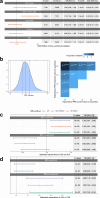This is a preprint.
Obstructive sleep apnea mediates genetic risk of Diabetes Mellitus: The Hispanic Community Health Study/Study of Latinos
- PMID: 39314966
- PMCID: PMC11419195
- DOI: 10.1101/2024.09.10.24313336
Obstructive sleep apnea mediates genetic risk of Diabetes Mellitus: The Hispanic Community Health Study/Study of Latinos
Abstract
Objective: We sought to evaluate whether obstructive sleep apnea (OSA), and other sleep disorders, increase genetic risk of developing diabetes mellitus (DM).
Research design and methods: Using GWAS summary statistics from the DIAGRAM consortium and Million Veteran Program, we developed multi-ancestry Type 2 Diabetes (T2D) polygenic risk scores (T2D-PRSs) useful in admixed Hispanic/Latino individuals. We estimated the association of the T2D-PRS with cross-sectional and incident DM in the Hispanic Community Health Study/Study of Latinos (HCHS/SOL). We conducted a mediation analysis with T2D-PRSs as an exposure, incident DM as an outcome, and OSA as a mediator. Additionally, we performed Mendelian randomization (MR) analysis to assess the causal relationship between T2D and OSA.
Results: Of 12,342 HCHS/SOL participants, at baseline, 48.4% were normoglycemic, 36.6% were hyperglycemic, and 15% had diabetes, and 50.9% identified as female. Mean age was 41.5, and mean BMI was 29.4. T2D-PRSs was strongly associated with baseline DM and with incident DM. At baseline, a 1 SD increase in the primary T2D-PRS had DM adjusted odds ratio (OR) = 2.67, 95% CI [2.40; 2.97] and a higher incident DM rate (incident rate ratio (IRR) = 2.02, 95% CI [1.75; 2.33]). In a stratified analysis based on OSA severity categories the associations were stronger in individuals with mild OSA compared to those with moderate to severe OSA. Mediation analysis suggested that OSA mediates the T2D-PRS association with DM. In two-sample MR analysis, T2D-PRS had a causal effect on OSA, OR = 1.03, 95% CI [1.01; 1.05], and OSA had a causal effect on T2D, with OR = 2.34, 95% CI [1.59; 3.44].
Conclusions: OSA likely mediates genetic effects on T2D.
Keywords: Diabetes; Hispanic or Latino; Obstructive sleep apnea; Polygenic risk score; Type 2 diabetes.
Conflict of interest statement
Competing interests Dr. Redline discloses consulting relationships with Eli Lilly Inc. Additionally, Dr. Redline serves as an unpaid member of the Apnimed Scientific Advisory Board, as an unpaid board member for the Alliance for Sleep Apnoea Partners and for the National Sleep Foundation.
Figures


Similar articles
-
Genetic determinants of cardiometabolic and pulmonary phenotypes and obstructive sleep apnoea in HCHS/SOL.EBioMedicine. 2022 Oct;84:104288. doi: 10.1016/j.ebiom.2022.104288. Epub 2022 Sep 26. EBioMedicine. 2022. PMID: 36174398 Free PMC article.
-
Associations between ankle-brachial index, diabetes, and sleep apnea in the Hispanic community health study/study of Latinos (HCHS/SOL) database.BMC Cardiovasc Disord. 2020 Mar 5;20(1):118. doi: 10.1186/s12872-020-01402-7. BMC Cardiovasc Disord. 2020. PMID: 32138679 Free PMC article.
-
[Obstructive sleep apnea and type 2 diabetes: a bidirectional Mendelian randomization study].Zhonghua Er Bi Yan Hou Tou Jing Wai Ke Za Zhi. 2023 Oct 7;58(10):974-979. doi: 10.3760/cma.j.cn115330-20230803-00032. Zhonghua Er Bi Yan Hou Tou Jing Wai Ke Za Zhi. 2023. PMID: 37840162 Chinese.
-
Polygenic risk scores and kidney traits in the Hispanic/Latino population: The Hispanic Community Health Study/Study of Latinos.HGG Adv. 2023 Jan 13;4(2):100177. doi: 10.1016/j.xhgg.2023.100177. eCollection 2023 Apr 13. HGG Adv. 2023. PMID: 36741942 Free PMC article.
-
Association of self-reported physical activity with obstructive sleep apnea: Results from the Hispanic Community Health Study/Study of Latinos (HCHS/SOL).Prev Med. 2016 Dec;93:183-188. doi: 10.1016/j.ypmed.2016.10.009. Epub 2016 Oct 14. Prev Med. 2016. PMID: 27746338 Free PMC article.
References
-
- American Diabetes A., Diagnosis and classification of diabetes mellitus. Diabetes Care, 2004. 27 Suppl 1: p. S5–S10. - PubMed
-
- Senaratna C.V., et al., Prevalence of obstructive sleep apnea in the general population: A systematic review. Sleep Med Rev, 2017. 34: p. 70–81. - PubMed
-
- Kono M., et al., Obstructive sleep apnea syndrome is associated with some components of metabolic syndrome. Chest, 2007. 131(5): p. 1387–92. - PubMed
Publication types
Grants and funding
- HHSN268201300005C/HL/NHLBI NIH HHS/United States
- HHSN268201300004C/HL/NHLBI NIH HHS/United States
- HHSN268201300003I/HL/NHLBI NIH HHS/United States
- N01 HC065233/HL/NHLBI NIH HHS/United States
- N01 HC065236/HL/NHLBI NIH HHS/United States
- N01 HC065235/HL/NHLBI NIH HHS/United States
- R01 HL161012/HL/NHLBI NIH HHS/United States
- HHSN268201300001C/HB/NHLBI NIH HHS/United States
- N01 HC065234/HL/NHLBI NIH HHS/United States
- HHSN268201300003C/HG/NHGRI NIH HHS/United States
- N01 HC065237/HL/NHLBI NIH HHS/United States
- R35 HL135818/HL/NHLBI NIH HHS/United States
- R01 AG080598/AG/NIA NIH HHS/United States
LinkOut - more resources
Full Text Sources
